|
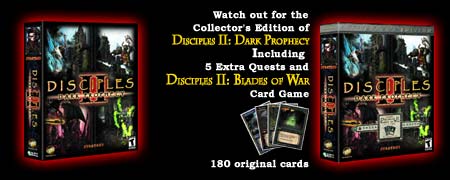
Disciples II: Blades of War
The Disciples II: Blades of War cardgame is the
card game that was included in the Collectors Edition of Disciples 2: Dark
Prophecy.
This is a strategic card game set in the Disciples
2 universe that doesn't require a computer!
Two to four players take turns controlling cities
and resources, attacking their opponents with hired leaders and units, and
eventually clearing the map of their enemies.
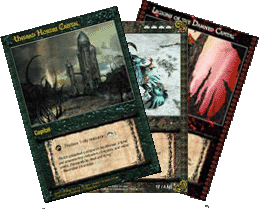
RULES
These are the official rules for the
Blades of War cardgame that is included in the Collectors Edition of
Disciples 2: Dark Prophecy. Re-typed by the webmaster of the Disciples 2
Dungeon.
Overview
This is a strategic card game set in the Disciples 2 universe that
doesn't require a computer!
Two to four players take turns controlling cities and resources,
attacking their opponents with hired leaders and units, and eventually
clearing the map of their enemies.
An introduction to the Game
As with many card games, you will each draw a hand of cards, kept hidden
from the other players. Each player will have his own unique deck
representing a specific race, and, consequently, different strategies.
In this game you will notice that there are different classes of cards
(which will be presented in the next section) such as resources, units,
items, spells, etc. Each type of card will be used in different
circumstances.
Remember that you're not limited in the amount of cards you can play in
one turn because your resources will dictate what you can accomplish.
This means that you won't always have the same amount of cards in your
hand.
One concept that you will use often is called "tapping". When you tap,
you will turn the card by at least 45 degrees and declare that you are
tapping that card's resources. Once a card is tapped, you may not reuse
it until it becomes untapped (generally at the beginning of your next
turn).
Card Types
City cards: These represent the cities that house and finance
your armies. They are also places of refuge for your parties that offer
more protection than the wilderness; the enemy can't cast spells on a
party that is inside a city. To use the gold a city generates, you must
tap the card. Each card will indicate how many cities you will need to
tap to play it. The Capital card in each deck also counts as a city
card, and can therefore be tapped.
Mana cards: You can play these on any spot where there can be no
cities (see the Strategic Map Diagram) if you own a city adjacent to the
space. Mana represents the magical energy needed to cast spells. There
are four kinds of mana, each of which is the main mana type for one of
the four races in the game: White (Runestone) mana is used by the
Mountain Clans, Blue (Life) mana is used by the Empire, Red (Infernal)
mana is used by the Legions of the Damned, and Black (Death) mana is for
the Undead Hordes. Some spells may have a casting cost of a combination
of mana colors. Mana must also be tapped in order to use its power.
Leader cards: You need a leader before you can begin to build an
army (party) and move around the playfield. Each side has three main
leaders for general combat and two specialty leaders, the Rod Planter
and the Thief.
Rod Planter: By planting rods on spots that have mana cards, a
player may capture that resource. A Rod Planter may convert mana to your
use if it is adjacent to the square holding the mana. This will cost the
Rod Planter one turn, but you may turn the mana card to face your
direction, indicating that you are the current owner.
Thief: Can be used to spy on, poison and steal from the other
players when in an adjacent square by tapping the card. Cities offer no
protection from the Thief unit.
Unit cards: You may only play unit cards in cities with leaders,
and you may only place them in parties that have enough unused
leadership points. You will need to make sure your leaders have enough
hired units to effectively combat your enemy.
Artifacts and other equipped items: a leader may only carry one
of these at a time, and they can affect him and/or his party during
combat. These cards can give attack and defensive bonuses, or new
special abilities.
Single-use magical item cards: Potions and orbs can only be used
once. They can only be played during combat, and they are played
directly from your hand. For example, these items can heal, enhance or
revive your units.
Spell cards: These are spells that can be cast using tapped mana,
affecting the units on the playfield or even the flow of the game. The
cards mention when the spell may be cast and the effect they will have.
Some can even be used during the other player's tuen! There are various
types of spells:
Events can be cast only on the caster's tuen. outside of
battle.
Instant Events can be cast at any time, except in battle.
Spells can only be cast on the caster's tuen, outside of
battle. These spells, which are very similar to the spells in the
Disciples 2 PC game, may only be cast on a space adjacent to a city the
caster owns.
Game Setup
Each player uses his own deck, takes out his Capital and places it in
front of him. Each player must choose one of the three main leaders(
neither a Thief nor a Rod Planter may be used) from their deck and place
in their capital (on top of the capital card).
Everbody shuffles their deack with the remaining two leaders, and
(optional) lets another player cut their cards.
Everbody then draws five cards.
Flip a coin to see which player goes first and if more than two players
are playing proceed with turns in a clockwise order.
If a player draws no cities on his first hand, he or she may reshuffle
his hand back into his or her deck and draw another hand of five cards.
Strategic Phase steps:
This is the strategic phase of play, which includes actions that do not
always apply every turn (for example, you won't have much to do on the
first turn). Steps that are optional are indicated with a *, all other
steps must be done if they're possible.
| 1.
|
Untap all cards. |
| 2.
|
Draw a card. |
| 3.
|
Heal all living units to maximum
HP. Living leaders get healed too, but dead leaders are revived only
if they are in their capital, otherwise they stay dead. |
| 4.
|
*Place one "equip" item card in
your capital per turn (Leaders must go to their capital to equip an
item). Battle item cards are left in your hand until you choose to
use them during combat. |
| 5.
|
*Play one City card in an open
city spot on the map (see Strategic Map Diagram). |
| 6.
|
*Play one Mana card in an open
mana spot on the map adjacent to a city you currently control (see
Main Game Diagram). |
| 7.
|
*Play one Leader card in your
capital (assuming you have enough cities to hire one). |
| 8.
|
*Play as many unit cards as you
wish (and have the hiring cost for) in your capital or in any of
your cities that contains a leader (with available leadership
points). |
| 9.
|
*Transfer units and items between
parties in adjacent spots (not that this is always done before
parties can move). |
| 10.
|
*Play spells on non-city spots
(cities are protected and can protect from spells). Remember that
you must pay the casting cots by tapping the correct amounts of mana. |
| 11.
|
*Parties may now move to any
available adjacent spot beside or in a city (no diagonal movements
allowed). Two parties may not occupy the same spot, and since
parties can move only once per turn, a party at a bottleneck on the
map will completely block movement. |
| 12.
|
*Declare battles. Only units that
have not moved may declare battles, and each party can only enter
battle once per turn. Battles are resolved as they are announced,
the player does not need to declare all of their battle once. Spells
may also be played during this phase, between battles (no spells can
be cast during battle). |
| 13.
|
Remove dead parties from the
table and place them in the cemetery (a seperate pile of cards
consistent of dead units and used spells). |
| 14.
|
*Use Leader special abilities
(Thief or Rod Planter) on valid targets. |
| 15.
|
*Play spells and events: here you
may play spells (healing spells, for instance) before ending your
turn. |
| 16.
|
Discard if you have more than 7
cards in your hand. You cannot end your turn with more than 7 cards
in your hand. Discarded cards go to your cemetery. |
| 17.
|
Declare end of turn. |
On the strategic map:
Any cities and mana cards a player places on the strategic map are
controlled until another player takes possession of them: a city is
conquered when a party from the conquering player enters that city
(which must be empty, if there was a party in the city, the conquering
player would have to defeat that party before entering), and mana cards
are taken by planting a rod on them using a Rod Planter.
Each city creates one mana space in each non-diagonal direction around
it. Leaders may travel freely in these areas and mana cards can be
places in any empty space adjacent to a city owned by the player placing
the mana.
If playing a two-player game, a player must own two cities in front of
their capital before they can add a city to the next row. Afterwards,
there must be at least two cities in one row before the player can place
cities in the next row. Once the complete map pattern is filled with
cities (excluding the capitals: see Strategic Map Diagram), players may
begin to place cities in branches away from the predefined areas.
Regular leaders have 3 leadership points, while Thieves and Rod Planters
have no leadership points.
Converted mana and captured cities are considered tapped until the new
owner's next turn.
In any game, if one player has no more cards in his deck, he or she must
finish the game with cards already in play.
Battle Phase Steps:
Use these steps every time a battle is declared on step 12 of the
Strategic Phase:
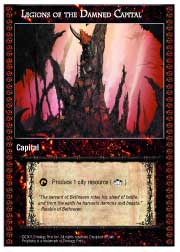  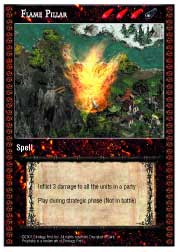
| 1.
|
Place units in formation on the
battleground (see the Battle Map), remembering that unirs which are
more vulnerable or those who have a ranged attack should stay in the
back row, while stronger units which a lot of HP should stand in the
front, to be able to attack the enemy, and sustain attack that would
otherwise kill less powerful units. |
| 2.
|
Apply item and spell modifiers.
All are cumulative. |
| 3.
|
The attacker chooses an unit to
attack, use a battle item, or a special ability, and then taps the
cars. |
| 4.
|
The defender chooses an unit to
attack, use a battle item, or a special ability, and then taps the
cars. |
| 5.
|
Repeat the process, alternating
units until all units are dead or tapped for that battle round. Once
all of both players' unit cards are tapped, the battle round is
finished. |
| 6.
|
Repeat the process, but for the
next round the Defender will launch the first attack. Each round
will alternate the first attack to the other player. |
| 7.
|
When all the units in one party
are dead, combat is at an end. All dead units other than the leader
from the winner's party are put into the cemetery. If you win but
have a dead leader and at least one living unit in your party, you
will need to return to your capital to revive the leader. For the
defeated party, all dead units and the leader are sent to the
cemetery. Place a completely defeated party's item in the cemetery
if applicable. |
| 8.
|
Return to strategic phase. |
Winning:
To win a regular game, one player must kill all of the other player's
parties on the strategic map.
Optional winning conditions:
A player loses if another player takes his capital.
Once all of a player's parties are dead, another player must take
that player's capital to win.
Teams may be created with a team goals similar to those listed
above.
Strategic Map:
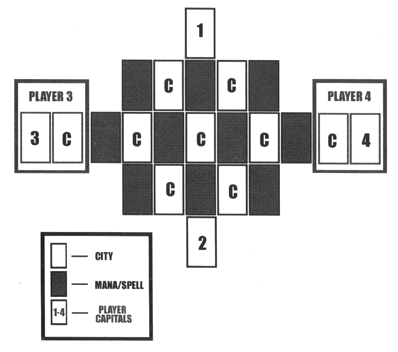
Battle Map:

|
|
|







